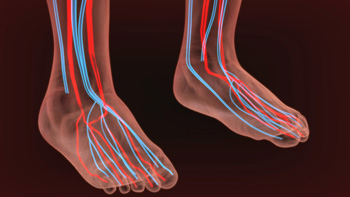Do Symptoms Always Appear With Peripheral Artery Disease?
Peripheral artery disease (PAD) is a condition in which blood flow to the lower limbs is inadequate. This typically occurs due to plaque buildup along the artery walls, which causes them to narrow and harden and restricts the amount of blood flow that can travel to the legs. Sometimes, people who have developed PAD do not experience any symptoms. Others however, may notice a tight, aching, or squeezing pain in the calves, leg cramps when walking, weakness, fatigue, and difficulty walking and balancing. When PAD progresses, symptoms like coldness or numbness in the lower limbs, leg and foot pain at rest, and slowly healing wounds may appear. A podiatrist can help you manage PAD and its effects on your feet and ankles. For more information about this condition please consult with a podiatrist.
Peripheral artery disease can pose a serious risk to your health. It can increase the risk of stroke and heart attack. If you have symptoms of peripheral artery disease, consult with one of the specialists from Thornhill Foot Clinic. Our chiropodists will assess your condition and provide you with quality foot and ankle treatment.
Peripheral artery disease (PAD) is when arteries are constricted due to plaque (fatty deposits) build-up. This results in less blood flow to the legs and other extremities. The main cause of PAD is atherosclerosis, in which plaque builds up in the arteries.
Symptoms
Symptoms of PAD include:
- Claudication (leg pain from walking)
- Numbness in legs
- Decrease in growth of leg hair and toenails
- Paleness of the skin
- Erectile dysfunction
- Sores and wounds on legs and feet that won’t heal
- Coldness in one leg
It is important to note that a majority of individuals never show any symptoms of PAD.
Diagnosis
While PAD occurs in the legs and arteries, Podiatrists can diagnose PAD. Podiatrists utilize a test called an ankle-brachial index (ABI). An ABI test compares blood pressure in your arm to you ankle to see if any abnormality occurs. Ultrasound and imaging devices may also be used.
Treatment
Fortunately, lifestyle changes such as maintaining a healthy diet, exercising, managing cholesterol and blood sugar levels, and quitting smoking, can all treat PAD. Medications that prevent clots from occurring can be prescribed. Finally, in some cases, surgery may be recommended.
If you have any questions, please feel free to contact our office located in Vaughan, ON . We offer the newest diagnostic and treatment technologies for all your foot care needs.

